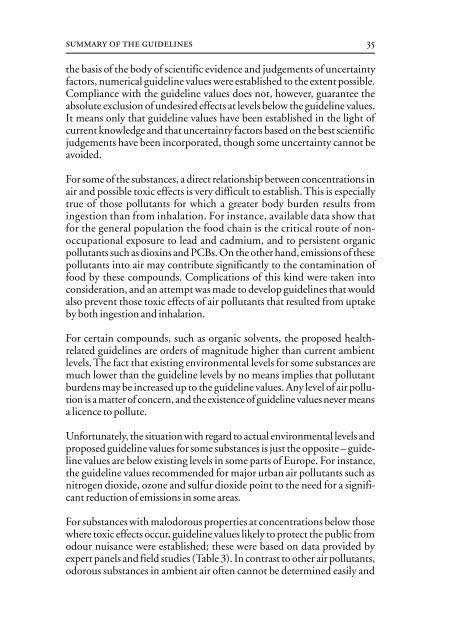Air Quality Guidelines - World Health Organization Regional Office ...
Air Quality Guidelines - World Health Organization Regional Office ...
Air Quality Guidelines - World Health Organization Regional Office ...
You also want an ePaper? Increase the reach of your titles
YUMPU automatically turns print PDFs into web optimized ePapers that Google loves.
summary of the guidelines<br />
the basis of the body of scientific evidence and judgements of uncertainty<br />
factors, numerical guideline values were established to the extent possible.<br />
Compliance with the guideline values does not, however, guarantee the<br />
absolute exclusion of undesired effects at levels below the guideline values.<br />
It means only that guideline values have been established in the light of<br />
current knowledge and that uncertainty factors based on the best scientific<br />
judgements have been incorporated, though some uncertainty cannot be<br />
avoided.<br />
For some of the substances, a direct relationship between concentrations in<br />
air and possible toxic effects is very difficult to establish. This is especially<br />
true of those pollutants for which a greater body burden results from<br />
ingestion than from inhalation. For instance, available data show that<br />
for the general population the food chain is the critical route of nonoccupational<br />
exposure to lead and cadmium, and to persistent organic<br />
pollutants such as dioxins and PCBs. On the other hand, emissions of these<br />
pollutants into air may contribute significantly to the contamination of<br />
food by these compounds. Complications of this kind were taken into<br />
consideration, and an attempt was made to develop guidelines that would<br />
also prevent those toxic effects of air pollutants that resulted from uptake<br />
by both ingestion and inhalation.<br />
For certain compounds, such as organic solvents, the proposed healthrelated<br />
guidelines are orders of magnitude higher than current ambient<br />
levels. The fact that existing environmental levels for some substances are<br />
much lower than the guideline levels by no means implies that pollutant<br />
burdens may be increased up to the guideline values. Any level of air pollution<br />
is a matter of concern, and the existence of guideline values never means<br />
a licence to pollute.<br />
Unfortunately, the situation with regard to actual environmental levels and<br />
proposed guideline values for some substances is just the opposite – guideline<br />
values are below existing levels in some parts of Europe. For instance,<br />
the guideline values recommended for major urban air pollutants such as<br />
nitrogen dioxide, ozone and sulfur dioxide point to the need for a significant<br />
reduction of emissions in some areas.<br />
For substances with malodorous properties at concentrations below those<br />
where toxic effects occur, guideline values likely to protect the public from<br />
odour nuisance were established; these were based on data provided by<br />
expert panels and field studies (Table 3). In contrast to other air pollutants,<br />
odorous substances in ambient air often cannot be determined easily and<br />
35

















